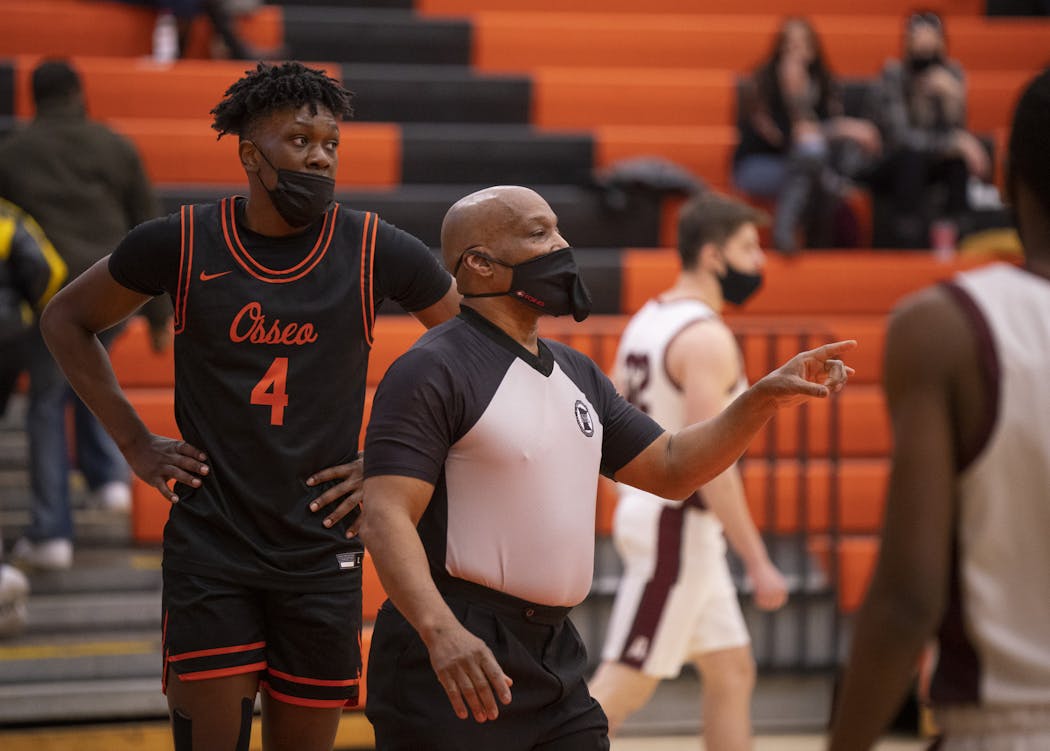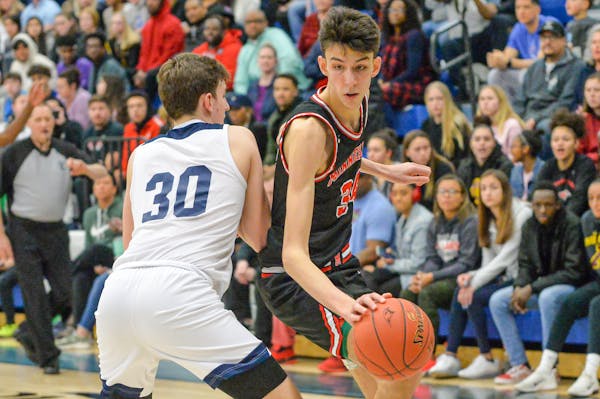After 16 years as a high school basketball official, Lamarr Sullivan was wary about year 17. In fact, he originally decided against it, the potential health costs of the COVID-19 virus too steep to ignore.
"I actually opted out in August," Sullivan said. "I have a granddaughter who just turned 1. And, of course, my wife."
But as the Minnesota season got closer, the lure of the whistle and the squeak of basketball shoes on a gym floor became stronger and harder to resist. Sullivan's career is that of an executive IT manager for the Minneapolis law firm of Carlson Caspers, but basketball is in his blood.
As the November election approached, Sullivan decided that if there was a change in administrations, he'd come back.
"I felt that there would be a more coherent and consistent strategy to combat the virus," Sullivan said.
Now, he's back officiating as many as six games a week. His return comes with changes in how officials work games to improve safety amid the pandemic.
It also comes as many longtime officials have chosen to step away, unwilling to expose themselves to the risks of COVID. Those departures have put an added strain on a group already feeling the pinch of dwindling numbers.
Gopher State Officials Association, one of the largest officiating bodies in the state, is down 90 officials from the 223 it represented last year, with 52 of those departures directly attributed to COVID concerns.
"We're at 157 right now," said Rick DeGardner, who has the task of assigning officials to games. "Some are normal losses, retirements and family concerns and thing like that. But COVID was the reason for a lot of them."
The story is similar across all officials associations. The Minneapolis Officials Association is down by 64 members this season. St. Paul Capital City Officials Association, another large metro organization, has had 43 officials opt out due to virus concerns.
"It is kind of strain," DeGardner said. "We don't have enough to cover all the games, particularly with everybody playing the traditional Tuesday-Friday schedule. We've had to notify schools we might not be able to cover their games."
Jason Nickleby, coordinator of officials wtih the Minnesota State High School League , said the state has seen a "15 to 20% drop in numbers going into winter and that has been consistent across the board."
“I don't feel less safe. I feel safer than I do when I go to the grocery store.”
Not every sport is down significantly — Nickleby cites swimming and diving, whose numbers have largely remained steady — and the drop in the number of available officials has been somewhat mitigated by the league restricting the number of contests allowed as seasons were shortened. For example, basketball is playing an 18-game regular season, eight fewer games than in a normal season.
"We're down maybe a little more in basketball, but those challenges have been evened out a bit by the reduced number of games and the limit of two games per week."
Safety-minded changes
In accordance with the Minnesota Department of Health, the high school league met with officials groups to devise new guidelines, tighten existing rules and implement protocols to ensure a greater level of safety and minimize contact during games.
Among them are encouraging officials not to arrive too early before a game and asking them to come in uniform since they are not allowed to access to a locker room before games. Without a locker room, private discussions and strategy sessions are difficult to have. And conversations with coaches and captains before games have been limited.
"We typically spend much of our time in the pregame preparation in the locker room, getting on the same page and talking about how we're going to address X, Y and Z," said Teron Buford, who officiates both high school and college basketball. "We have to have those conversations on the fly and that makes it tough to get on the same page."
After games, there are no postgame showers. "The message is get in and get out," said Tim Leighton, the league's director of communications who is in his 30th season as an official.
Not the mask police
Restarting winter sports seasons in January came with a state-mandated requirement for players, coaches, officials and fans to wear masks to help limit virus transmission. Compliance on the court during games is often wanting. Noses are frequently exposed and, as players look for an edge, some wear them more like a chin strap.
The ultimate enforcement on mask-wearing lies with game officials. Most of them believe that, while there is still a ways to go to get full compliance, the situation isn't as dire as photos and videos might suggest.
"A picture is just a snapshot in time," said Nickleby, reasoning that masks move about frequently during play. "It doesn't always accurately depict what might be occurring."
A mask may slip down because of a strong head fake, or in the process of battling for a rebound. It might get knocked down by a defender or slide down in a scramble for a loose ball.
"We're not trying to be the mask police," said longtime official Craig Laird, who is also the clinician for Gopher State Officials. "It is another rule you have to enforce, but overall most coaches and players have been pretty good about wearing their masks."
Added Sullivan, "The simplest way is during any dead ball, without singling anyone out or directly looking at a player, I tell them to 'mask up.' And if they don't pull it all the way up, I'll just say 'I need it up over the nose.' I have yet to remove a player from a game because of it."
Buford said it's all part of working together to adjust to a significant change.
"Part of it I attribute to invincibility factor with teenagers," he said. "They really believe it's not going to happen to me. So I try to give them a little bit of understanding."
Nickleby believes that compliance has been remarkably good considering how quickly players have had to adjust. Mask-wearing was optional during fall sports and didn't become mandatory until winter practice started Jan. 4. Games began 10 days later.
"It's something they've never done before and now to expect total compliance in less than a month?, Nickleby said. "What chance is there of that?"
Some moves welcomed
Some of the procedural changes have, in fact, been welcomed by officials. Nickleby expects the dependence on virtual meetings for things such as clinics and rules meetings to continue.
“The simplest way [to enforce the mask rule] is during any dead ball, without singling anyone out or directly looking at a player, I tell them to 'mask up.' And if they don't pull it all the way up, I'll just say 'I need it up over the nose.' I have yet to remove a player from a game because of it”
Officials are expected to limit direct contact with players and distance themselves whenever possible no longer hand the ball to players on inbounds plays and free throws. Instead, they stand at least six feet away and bounce the ball to them. It's a change Laird loves.
"On inbounds plays, I used to hand the ball to [the player], then I'd have to move into the proper position," he said. "Now, I'm already in the right place. I like it better this way."
The lack of noise in school gymnasiums, which limit fans and cheerleaders and no longer allow bands, have made officials more aware of how they deal with players and coaches. There are no secrets.
"It makes you very cognizant of what you're saying," Buford said. "If I have to think about what I'm saying, I probably shouldn't say it."
Fans, too, tend to behave themselves better when their actions stand out. "We can hear them way better than we did before," Laird said with a laugh. "I've only had one or two go over the line."
Most believe the steps taken have significantly improved safety while allowing the game to go on.
"I don't feel less safe," Laird said. "I feel safer than I do when I go to the grocery store."


